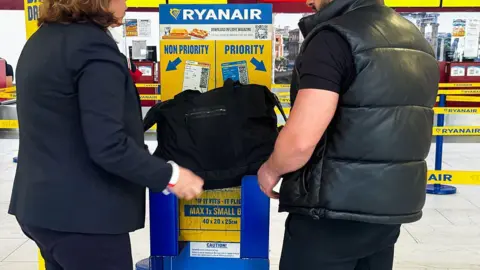Remember when planning a work trip felt like a second job? Finding the right venue, plotting meetings and navigating new cities could take hours, if not days. Now, AI tools are making that grind redundant, allowing professionals to streamline schedules, find their way and execute trips with efficiency that once seemed impossible.
Why AI is becoming essential for modern travelers
More and more, travelers are leaning on AI to take the guesswork out of getting from point A to B. From finding the fastest route through a new city to suggesting the right restaurant for a client lunch, these tools are becoming indispensable. Business travelers, in particular, are embracing them like a secret weapon, letting AI handle scheduling, directions and even meeting arrangements so they can focus on more important tasks.
Booking.com’s latest Global AI Sentiment Report paints a clear picture of a world increasingly reliant on AI for travel. Nearly 9 in 10 consumers say they want to use AI tools for planning their trips, while 24% trust AI assistants more than travel bloggers, who garner just 19% confidence. With AI capable of recommending activities, mapping routes and even managing bookings, travelers are embracing digital help at every step.
The July report found that 67% have already used AI in some aspect of travel, with nearly all using it to plan or book trips (98%) or while on the go (96%). Most commonly, AI helps with researching destinations and best travel times (38%), finding local cultural activities (37%) and recommending restaurants (36%).
Using AI to plan multicity business trips and smart layovers
There are various AI tools you can use to kickstart your plans. Hopper, for example, uses machine learning to analyze historical fare data and predict when ticket prices will rise or fall. Just enter your destination and travel dates and set alerts, and its AI will notify you of the best time to book—especially handy if you can be flexible, unlocking potential savings.
Skyscanner is another go-to. Enter your origin, destination and dates, and its AI scans thousands of airlines, routes and prices. Swap nearby airports, adjust your dates or explore multicity options to save even more. Its layover suggestions let you either reach your destination quickly or grab some productive work time midjourney.
If you’ve ever wished for a personal travel assistant who can help with flights, layovers and hotel options, Skyscanner’s chatbots—available across platforms like Facebook Messenger, Skype and Amazon Alexa—are as close as it gets.
Since launch, they’ve surpassed one million unique traveler interactions, offering AI-powered guidance on finding the best flights, alternative routes and nearby airports. While not a traditional chatbot on the Skyscanner website or mobile app, these bots let users interact via messaging or voice, helping them search and explore travel options in a more conversational way. Once the bot helps you identify your ideal flight, it always directs you to the Skyscanner website or app to complete the booking. This means you get the convenience of a conversational AI to narrow down options, but all final selections, price comparisons and bookings happen on Skyscanner’s main platform.
Midtrip, it doesn’t just sit there: It can give advice on layovers, shuttle options, airport services and even local tips to make the journey smoother. And when it’s time to share your experience, the chatbot can even help you draft reviews for flights or hotels.
Chatbots like ChatGPT and Copilot are other useful digital companions to consider on your travels. Ask them to compare airlines, check flexible dates or find faster, cheaper routes. Refine prompts with instructions like, “Show flights with layovers under three hours” or “Get me there in time for a morning meeting.” They can also handle the smaller details like finding airport workspaces, shuttles, baggage rules and perks. For busy executives, these tools make flying cheaper, faster and stress-free, so you can focus on work, not tabs.
Study: Over half of global travelers would let AI book their trips
A recent survey by Talker Research shows younger Americans in particular are increasingly turning to AI, including ChatGPT, to plan study getaways. Among 2,000 respondents evenly split by generation, only 29% of millennials and 33% of Gen Z reported never using AI for trip planning, compared with 70% of baby boomers who stick to traditional methods.
According to Accenture, AI is becoming an essential part of the travel toolkit not just in the U.S, but globally. Among 18,000 respondents across 14 countries, over half said they would let AI manage their bookings, while frequent generative AI users are increasingly turning to it first for discovering destinations.
Using AI to optimize travel schedules around meetings
Why waste a layover in a boring terminal? AI mapping tools can plot your day so you crush your meetings and explore the city at the same time. It can identify shortcuts, suggest nearby attractions and even flag hidden gems, letting you make the most of every spare hour without stressing about travel logistics.
Take MindTrip: Enter your destination, travel dates and priorities, and it instantly maps out a full itinerary from flights, hotels and restaurants to personalized cultural experiences. For busy executives, it’s a lifesaver: the platform can suggest the perfect nearby gallery or café to prep for a meeting, sneak in a bit of leisure, or simply stretch your legs. A tight schedule suddenly feels manageable.
What makes it even smarter? You can chat with MindTrip’s chatbot to refine your plans in real time so you can swap activities, adjust meeting times or explore hidden gems, all through a conversational interface. Teams can collaborate too, planning flights, hotels and meetings together, while the platform tracks bookings and divides expenses.
The real advantage comes when you let these tools learn your habits. They start to anticipate your preferred airlines, optimal meeting times and even the best workspaces in unfamiliar cities. That means less time fretting over logistics and more time focusing on the purpose of your trip. Treat AI as your unseen travel assistant, and suddenly, business trips feel less like a grind and more like a well-oiled operation.
Photo by Ground Picture/Shutterstock
























